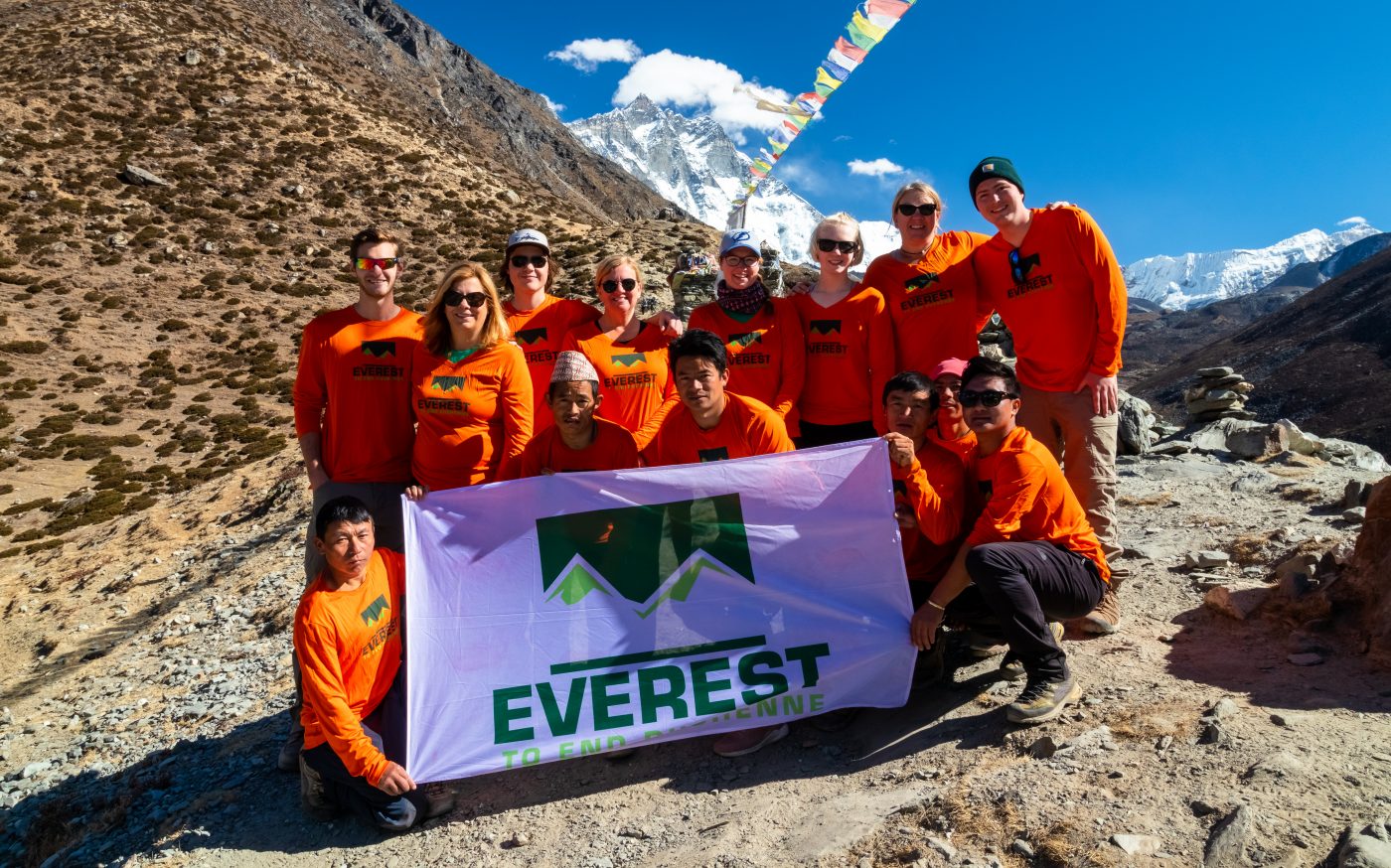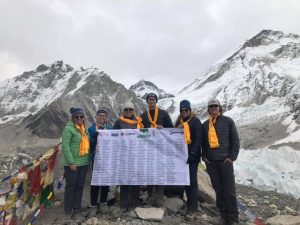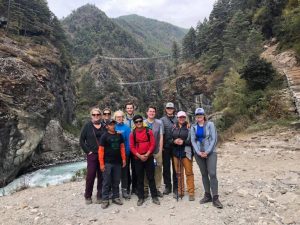Mount Everest Base Camp Trek Raises $60K for Duchenne Research

The eight-person Everest to End Duchenne team plus guides pose in front of Mt. Everest. (Photo courtesy of Hope for Gus)
Tonya Dreher wanted to do something dramatic on behalf of Hope for Gus, the New Hampshire-based foundation inspired by her son, Gus, 14, who has Duchenne muscular dystrophy (DMD). In 2015, frustrated with her fundraising efforts on behalf of DMD research, she came up with the idea of Everest to End Duchenne.
“I was trying to think big, and it was the biggest mountain in the world,” Dreher said. “The next thing I knew, I was shouting it out over social media and then I couldn’t back down.”
Last November, thousands of miles away in Nepal, Dreher and seven others embarked on the foundation’s third Everest to End Duchenne trek. On Nov. 15, at an altitude of 17,500 feet above sea level, the six who made it all the way to base camp unfurled a flag with the names of 750 boys with Duchenne, including some who have died from the disease, as the wind whipped around them.
“I think it’s important to think about the discomfort that all of us have experienced at some point on the trip, and that’s probably very small compared to what our boys feel most of the time,” Dreher said in a video. “It’s a privilege and an honor to bring their names to base camp and to read them into the wind over the rooftops of the world.”
Getting to base camp wasn’t an easy accomplishment for the team, both logistically and physically.
Climbers had to raise their own money to cover airfare to Kathmandu, gear, and lodging for the 17-day trip. Corporate sponsors Full Circle International and Sarepta Therapeutics, along with organizational sponsors Parent Project Muscular Dystrophy (PPMD) and JB’s Keys, helped cover additional costs.
The team flew from Kathmandu to the small city of Lukla, where they began their 74-mile trek to base camp — an upward climb of 10 miles a day for two weeks. Along the way, they visited Buddhist monasteries, learned about Sherpa culture, and had two days of rest and acclimation.
Two climbers were unable to reach base camp because of altitude sickness. Dreher sprained her ankle four weeks before the trip, also adding to her difficulties. Yet she finished the trek despite her doctor’s apprehensions.
Other climbers included Dreher’s daughter Isabel, 18, and two other mother-child teams — Natalie Annis and Zane, 16, and Mindy Cameron and Ross, 23. Also on the team were Robin Lee, former executive director of the Muscular Dystrophy Family Foundation, and photographer Brock Reed.
Each team member has some kind of connection to Duchenne, “which makes a huge difference,” Dreher said.
Cameron, an Indiana resident whose youngest son, Cristopher, 18, has DMD, is also a carrier, which causes muscle weakness. In 2016, she was diagnosed with cardiomyopathy, and an MRI test showed some fibrosis (scarring). One year later, she had five episodes of irregular heartbeats.
“I’m not going to let this prevent me from going,” said Cameron, advocacy director for the Little Hercules Foundation.
Dreher said Cameron helped her get past her own adversity. “The fatigue that we experienced was nothing compared to what she did,” Dreher said.
In the last climb two years ago, Hope for Gus raised $100,000 for CRISPR/CAS9 research by molecular biologist Eric Olson, PhD. This year, the foundation allocated the $60,000 it raised from the trek toward expanding a Pentagon-funded cardiac initiative studying sudden death in Duchenne through PPMD.
The money will allow Elizabeth McNally, MD, PhD, a cardiologist and molecular geneticist at Northwestern University in Evanston, Illinois, to collect more data on heart rhythms in DMD with a loop recorder.
But collecting donations was only part of the trek’s objective; it was about honoring Duchenne patients as well.
“We were also taking these boys to a place that they could never possibly go themselves,” Cameron said.








